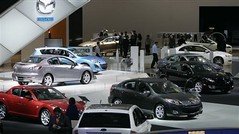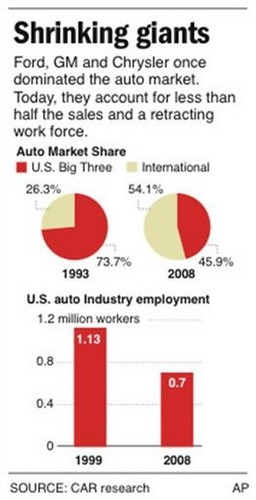Report: Smart Transportation Economic Stimulation: Infrastructure Investments That Support Strategic Planning Objectives Provide True Economic Dev.

The Mazda display is seen at the North American International Auto Show in Detroit, Tuesday, Jan. 13, 2009. (AP Photo/Carlos Osorio)
From Todd Alexander Litman, Victoria Transport Policy Institute
Smart Transportation Economic Stimulation: Infrastructure Investments That Support Strategic Planning Objectives Provide True Economic Development
Summary
This timely new report discusses factors to consider when evaluating transportation economic stimulation strategies. Transportation investments can have large long-term economic, social and environmental impacts. Expanding urban highways tends to stimulate motor vehicle travel and sprawl, exacerbating future transport problems and threatening future economic productivity. Improving alternative modes (walking and cycling conditions, and public transit service quality) tends to reduce total motor vehicle traffic and associated costs, providing additional long-term economic savings and benefits. Increasing transport system efficiency tends to create far more jobs than those created directly by infrastructure investments. Domestic automobile industry subsidies are ineffective at stimulating employment or economic development. Public policies intended to support domestic automobile sales could be economically harmful in the long-term.
Conclusions
Many types of public investments can stimulate short-term employment and economic activity but some are better overall because they also support other strategic goals. Smart economic stimulation responds to future demands and helps achieve various economic, social and environmental objectives. This study indicates that highway rehabilitation and safety programs are economically beneficial, but urban highway expansion tends to stimulate more driving and sprawl, exacerbating transportation problems. Demographic and economic trends reduce highway expansion benefits and increase demand for high quality alternatives. Investments that improve alternative modes tend to provide greater total benefits.
Increasing transport system efficiency is particularly important for long-term economic development. Vehicle and fuel purchases generate fewer domestic jobs and less economic activity than most other consumer expenditures. Each million dollar shifted from purchasing fuel to a typical bundle of consumer goods adds 4.5 U.S. jobs, and this is likely to increase significantly in the long run as international oil prices rise and domestic production declines. Each million shifted from general motor vehicle expenditures (purchase of vehicles, servicing, insurance, etc.) adds about 3.6 U.S. jobs. Public transit operations create a particularly large number of jobs.
A reasonable scenario of aggressive fuel economy targets, investments in alternative modes and supportive land use policies can reduce U.S. fuel consumption 20-40%, saving future consumers $150-350 billion annually in fuel and vehicle expenses, providing economic benefits from reduced fuel import costs of similar magnitude, producing additional economic, social and environmental benefits, and generating 1 to 2 million additional annual domestic jobs. This equals the total (not annual) jobs created by $30 to $60 billion of infrastructure expenditures and is five to ten times greater than the jobs provided by domestic vehicle manufactures.

Speaking of fundamental transformation and the issues faced by those of us in the United States, the cover story for Sunday's New York Times Magazine lays out the problem pretty well. See "The Big Fix - Can Barack Obama Really Transform the U.S. Economy."
The discussion in the article about Mancur Olson's book, The Rise and Decline of Nations: Economic Growth, Stagflation, and Social Rigidities, which says that with longevity and the lack of exongenous shocks to the system, over time organized interests groups use their access to capture greater proportions of social and economic gains at the expense of other actors and long term investment, is particularly good. (Olson also wrote the classic book The Logic of Collective Action.)



0 Comments:
Post a Comment
<< Home